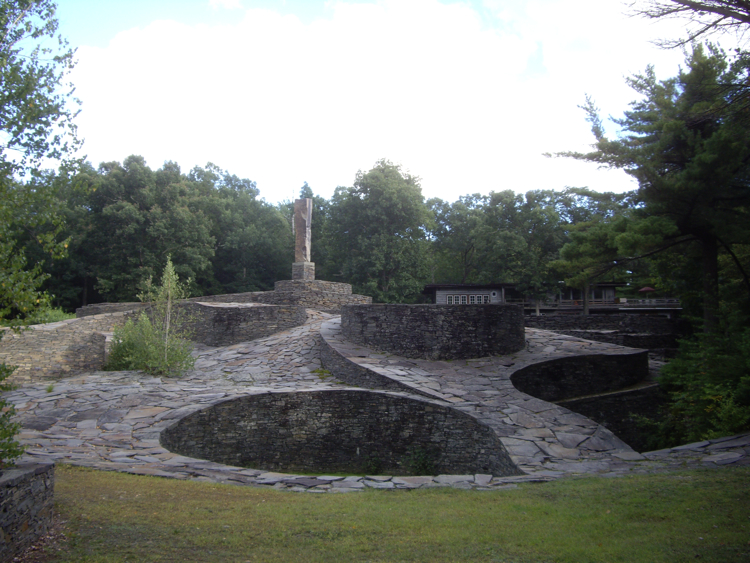Short answer: well
it depends. Quarry screenings (if available in your area) are
generally best for under the flagstones. Screenings are also one of
the best options for inbetween the stones, but there are other
options available which can be utilised to achieve different
aesthetic effects. First we will adress the structural issue “what
to use beneath the flagstone”.
Cement—it will
crack
Sand—ants will
dig it up and get it all over the place...also the sand may wash
away, causing stones to settle.
Gravel—really no
problems here, just use the right type of gravel. Better yet, use
modified gravel for the foundation and then use quarry screenings aka
grit aka quarry dust as the final leveling agent.
Longer story:
Cement will crack.
Especially grade level cement. Especially in a climate with winters
like ours in Pennsylvania. Worse way to go about it would be to lay
the stone upon a bed of gravel and then cement the joints between
stones. Horrible idea. The gravel base is flexible and will move ever
so slightly during freeze-thaw. Well, if the base was done poorly the
movement might be more then slight, but let's assume the base was
done well. A gravel base will definitely move a bit—looking at any
of my patios, you'd never know that, but the movement does happen.
Cement is rigid—if you put a rigid top on a flexible base then
systemic cracking is inevitable.
Cement is of
course a fine joint filling material if the flagstone happens to rest
upon a concrete foundation. But why on earth would you want to have a
concrete foundation anyway? The concrete itself will crack,
eventually. In a northern climate it will likely crack within ten
years—and the chances of it cracking within the next three years
are pretty high too. Environmental impact of concrete production is
no small isue either. Anyway, I personally prefer dry stone work.
More harmonious, warmer, just better.
Sand....well, if
you use a really heavy sand you should be alright. Most of the sands
that are packaged for sale however are way too fine. You can use a
course sand for under the flagstones, sure. Back when I used to lay
brick patios I would use course sand or quarry screenings
inter-changably and it was fine. Them patios still look good.
Not as good as my
stone patios though! Problem with using even course sand beneath
flagstone is this: Bricks are of uniform thickness. Thus it's not too
much trouble to just get your gravel foundation pretty close to
perfect, then go ahead and screed out one quarter inch of sand for
your bricks to rest upon. With flagstone however the thickness will
vary too greatly—you may need half an inch of sand for one stone,
but 2 inches for another—that'll cause problems. Screenings are
almost the same thing as modified gravel—they are indeed one of the
two ingredients in modified gravel...they are heavy enough that it
really is no problem to use 2 inches on one stone and half an inch on
another—ten years down the road, that patio will still look sharp.
Another reason to
use screenings is because screenings also make an excellent joint
filler. You do not want to use sand, even course sand between your
flagstone joints because it can wash away—unless of course your
flagstones are absurdly tight. For pattern-cut flagstone, yes, you can
get away with using sand as the joint-filler. Just make sure the base
is course sand, not fine. You will need to use fine sand for the
joints however because of how tight they are. Again, ants love fine
sand—but in this application, pattern-cut stones, tiny joints—fine
sand will not be the end of the world—so long as the base is
course, of course.
Back to
screenings—when you use screenings for both the leveler and the
joint filler you are creating a good scene. If there is ever any
minor issue with the screenings underneath the stone it shouldn't
matter too much because the joint filler will settle down and fill
the void. Having screenings up top and down below, it just works out
well.
You can expect to
top off the screenings once within the first year—a small bit will
settle or wash away. No problem, just sweep in some new material and
you're good. After that, in future years, you'll be fine. My best
recommendation is that clients hire me to do maybe a couple hours
maintenance once a year—by no means is this nessesary, but I like
my work to sparkle.
I should maybe
also add that using the above system I have never once had a single
patio fail. Okay, maybe one stone with some minor settling—fixable
in a few minutes (and rare that that ever happens) but never any
major problems. Been doing this a little while too.
More here https://www.facebook.com/DevineEscapes
.JPG)






